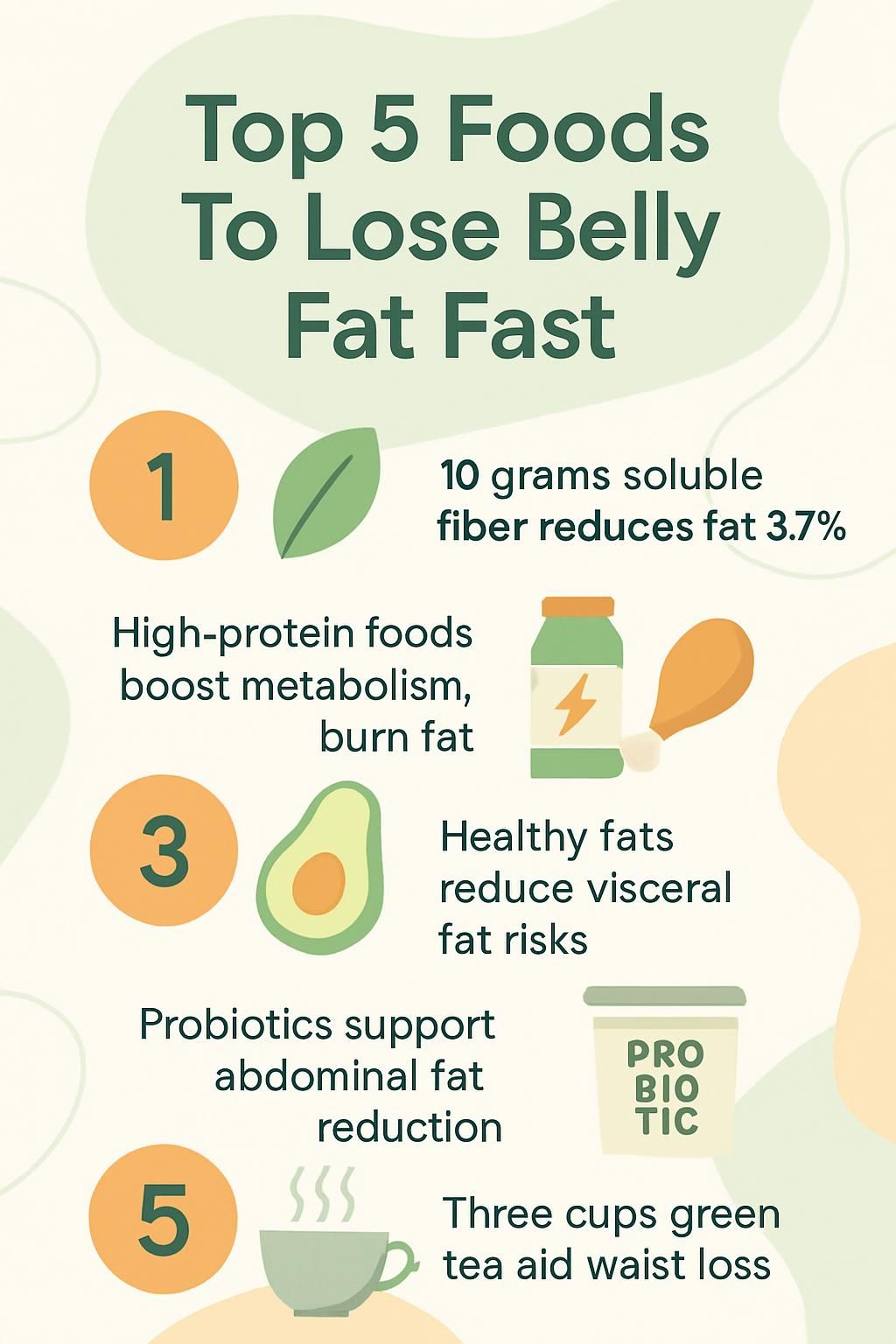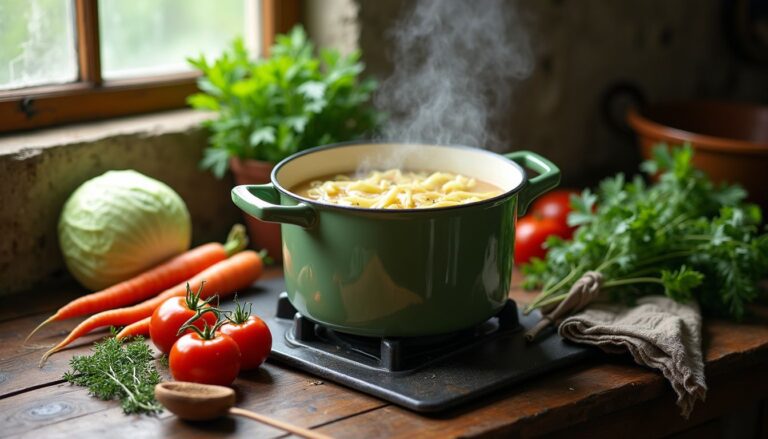Top 5 Foods To Lose Belly Fat Fast
Our Nutrition Assistant AI Suite will transform your body. You will lose fat, get toned, and build muscle. Gain confidence and optimal health.
Belly fat can feel stubborn, and it can harm your health. Extra fat around your waist raises the risk of heart disease, type 2 diabetes, and metabolic syndrome. You can lose belly fat with smart food choices and steady habits. This guide shows you how the top foods work, why they matter, and simple ways to use them today.
The advice here is educational and does not replace medical care. If you have a health condition or take medication, talk with your clinician before making big diet changes.
Key Takeaways
- Adding about 10 grams of soluble fiber daily from beans or oats was linked to a 3.7% belly fat reduction over five years in a 2012 study.
- High-protein foods, such as chicken, fish, eggs, tofu, and lentils, support muscle and raise metabolism, which helps you burn more calories.
- Healthy fats from avocados, nuts, seeds, olive oil, and fatty fish can lower LDL cholesterol and may reduce visceral fat according to USDA data and AJCN findings from 2020.
- Probiotics in yogurt and kefir were tied to greater abdominal fat loss versus control diets, reported in Nutrition Journal research in 2022.
- Green tea contains catechins, a type of antioxidant. Drinking it daily can increase calorie burning and support a smaller waist in several trials.

Understanding Types of Belly Fat

Belly fat sits in two main places, under the skin and deep inside the abdomen. Knowing the difference helps you target the right habits.
What Is the Difference Between Subcutaneous and Visceral Fat?
Subcutaneous fat is the soft layer under your skin that you can pinch. It often gathers around the hips, thighs, and waist. Visceral fat sits deeper in the abdomen and wraps around organs like the liver and intestines.
Visceral fat is considered active tissue because it releases compounds into the bloodstream. Higher levels link to insulin resistance, heart disease, type 2 diabetes, and some cancers. Subcutaneous fat affects appearance and comfort, yet usually carries a lower medical risk.
Even at a normal weight, too much visceral fat can raise health risks. That is why waist size and body composition, not just the scale, matter for your long-term health.
How Does Belly Fat Affect Your Health?
Excess visceral fat crowds organs and releases chemicals that drive inflammation. It can also worsen how your body uses insulin, the hormone that manages blood sugar.
Research cited by the National Institutes of Health shows abdominal obesity is a strong risk factor for cardiovascular disease. A high waist circumference predicts more problems with cholesterol, blood pressure, and glucose control.
Stress hormones like cortisol can increase abdominal fat storage. A healthy diet with fewer calories, plus regular aerobic exercise, helps reduce both the surface fat under the skin and the deeper visceral fat that affects health the most.
What Are the Best Dietary Strategies to Reduce Belly Fat?
Create a calorie deficit, which means you eat fewer calories than you burn. Fill your plate with dietary fiber from vegetables, fruit, beans, and whole grains. Soluble fiber, the type that forms a gel in your gut, may reduce visceral fat over time.
Cut back on added sugar and sweetened beverages. These drinks add calories fast and push fat gain around the waist. Choose lean proteins like fish, chicken, eggs, tofu, or beans to build muscle. Muscle tissue burns more calories, even at rest.
Favor healthy fats from avocados, olive oil, nuts, and seeds. Stay hydrated since drinking water before meals can help you eat less. Think whole foods most of the time. Keep portions moderate so you can stick with these habits for the long run.
Five Effective Foods to Trim Belly Fat Quickly
Certain foods make it easier to lose weight and shrink your waist. Focus on fiber, protein, healthy fats, probiotics, and smart beverages. Small, steady changes add up.
Which High-Fiber Foods Help Lose Belly Fat?
Beans, lentils, oats, and whole grains boost your soluble fiber intake. Soluble fiber can reduce appetite and slow calorie absorption. A 2012 study found that adding 10 grams of soluble fiber per day linked to a 3.7% drop in belly fat over five years.
Apples, pears, berries, carrots, and broccoli keep you full with fewer calories. Try a bean and veggie soup for lunch, or swap chips for sliced fruit. Simple swaps help you manage hunger and reduce extra snacking later.
“A small change like swapping chips for raw veggies helped me feel satisfied without gaining weight.”
Build meals around fiber-rich produce and grains. Over time, this pattern supports a leaner waist and steadier energy.
How Do Brown Rice, Quinoa, and Oats Aid Fat Loss?
Brown rice, quinoa, and oats provide complex carbohydrates and fiber. Fiber stretches fullness, which can control food intake. Studies from the Harvard T.H. Chan School of Public Health link higher whole grain intake with less visceral fat compared to refined grains.
Oats release energy slowly, which steadies blood sugar and reduces cravings. These grains also fuel your workouts so you can build muscle. Replacing refined grains like white bread with brown rice or quinoa supports a smaller waist over time.
Why Are Apples, Berries, and Pears Good for Belly Fat?
Apples, berries, and pears are rich in fiber that helps you feel full longer. They also blunt blood sugar spikes after meals. That reduces the urge to snack and lowers the chance of storing extra abdominal fat.
Berries supply antioxidants that may ease inflammation in fat tissue. Research from Harvard suggests more flavonoid-rich fruit, including apples and berries, is linked with lower visceral fat. Keep fruit handy to replace sweets or pastries in the afternoon.
What Are the Benefits of Broccoli, Spinach, and Carrots?
Broccoli, spinach, and carrots are low in calories and high in nutrients. All three provide fiber that supports fullness and healthy digestion.
Broccoli contains helpful plant compounds that support fat metabolism. Spinach offers iron and magnesium that assist muscle function during activity. Carrots add beta-carotene and vitamin A for cell health and immunity. Diets rich in these vegetables are linked to smaller waistlines and better heart health.
Which Protein Sources Support Lean Muscle and Fat Loss?
Lean meats like chicken and turkey deliver plenty of protein with little saturated fat. Fish such as salmon and tuna add omega-3 fats that support heart health while you lose weight. Eggs offer complete protein and essential vitamins in a small calorie package.
Plant proteins, including tofu, lentils, black beans, and chickpeas, supply both protein and fiber. That combo helps control appetite. Pick a mix of animal and plant sources to match your taste and goals.
Can Chicken, Fish, and Eggs Help Reduce Belly Fat?
Chicken, fish, and eggs support muscle growth and help increase daily calorie burn. Protein promotes fullness, so you eat fewer empty calories. Choose skinless chicken breast or grilled fish instead of processed meats to avoid extra saturated fat.
Fatty fish like salmon provide omega-3 fats that can reduce inflammation. One large egg has fewer than 80 calories yet supplies high-quality protein. Try eggs at breakfast to start the day satisfied and set up better choices later.
How Do Tofu, Beans, and Lentils Contribute to Fat Loss?
Tofu, beans, and lentils are budget-friendly protein sources that fill you up. They combine protein and fiber, which slows digestion and steadies energy. Harvard research suggests eating more legumes can support weight loss even without strict calorie limits.
One cup of cooked beans or lentils delivers meaningful protein plus 7 to 9 grams of fiber. Swapping a meat-based entrée for a tofu stir-fry or lentil chili can lower saturated fat intake while keeping meals satisfying.
What Are the Best Sources of Healthy Fats for Belly Fat Loss?
Choose fats that support your heart and waist. Avocados, nuts, and seeds provide mostly monounsaturated and polyunsaturated fats. These fats may improve cholesterol and help regulate hormones tied to appetite.
Fatty fish like salmon, trout, and sardines deliver omega-3 fats that support heart health and may lower visceral fat risk. Olive oil is a smart cooking and salad choice to replace butter or creamy dressings.
How Do Avocados, Nuts, and Seeds Help Trim Belly Fat?
Healthy fats can keep you full and support weight control. Avocados, nuts, and seeds help manage hunger hormones, which makes it easier to avoid grazing between meals.
People who include these foods often gain less weight around the waist. One ounce of mixed nuts has about 160 calories along with fiber, protein, vitamin E, and magnesium, according to the USDA [1]. Research from Loma Linda University reported that eating half an avocado at lunch lowered appetite by nearly 40% over three hours.
What Role Do Olive Oil and Fish Oil Play in Fat Reduction?
Olive oil is rich in monounsaturated fats that support fullness and weight control. In a 2020 American Journal of Clinical Nutrition study, replacing butter or margarine with olive oil helped reduce waist size over 12 weeks.
Fish oil provides omega-3 fats called EPA and DHA. These may reduce inflammation and improve insulin action. In one study of postmenopausal women published in Obesity, fish oil supplements were linked with greater abdominal fat loss compared to controls.
Using extra virgin olive oil on salads and cooking fish a few times a week are practical moves. These swaps often increase meal satisfaction and cut calories from heavy sauces.
Which Probiotic Foods Improve Digestive Health and Fat Loss?
Probiotics are live, helpful bacteria that support gut health. Yogurt and kefir supply these microbes and may reduce how much fat the body stores, especially near the waist.
Fermented foods like sauerkraut, kimchi, and miso contain similar cultures that can improve digestion and lower inflammation. One 2022 trial showed people who ate probiotic-rich yogurt lost more abdominal fat than a control group.^[1]
Adding at least one serving of probiotic foods daily might support appetite control and better weight trends.
How Do Yogurt, Kefir, and Sauerkraut Benefit Belly Fat Loss?
Yogurt, kefir, and sauerkraut help build a healthy gut environment. A balanced gut can influence hunger hormones and inflammation, both tied to fat storage around the midsection.
A 2020 study linked probiotic-rich foods with smaller waistlines compared to diets without them. Greek yogurt with fruit or a side of sauerkraut at lunch offers nutrition with few calories and steady satisfaction.
What Are the Effects of Kimchi and Miso on Belly Fat?
Kimchi and miso are fermented foods that add flavor and probiotics. Kimchi can increase the diversity of gut microbes, which supports digestion and may calm inflammation linked to abdominal fat. Miso, made from soybeans, provides plant protein and unique probiotic strains.
In a 2021 trial, adults who ate about half a cup of kimchi daily lost more abdominal fat than those who did not¹. Miso can be an easy soup base for lighter meals that still keep you full.
What Other Foods Can Help Burn Belly Fat Quickly?
Spices like cayenne and turmeric show promise. Cayenne contains capsaicin, which may raise metabolism and reduce appetite. Curcumin, the active compound in turmeric, may ease inflammation that slows fat loss.
Whole fruits such as grapefruit have been linked with modest weight loss. One 2006 study in Metabolism found that eating half a grapefruit before meals was tied to greater weight loss over 12 weeks. Green tea is another solid choice because its catechins can increase calorie burn.
Swap soda for unsweetened green tea or fruit-infused water to cut added sugar. Choose snacks like air-popped popcorn or Greek yogurt with nuts. Aim for 150 minutes of exercise per week and consistent sleep, which enhance your efforts.
How Does Green Tea Support Belly Fat Loss?
Green tea contains catechins that help your body break down fat. Caffeine and catechins together may increase daily calorie burn. Studies show regular green tea drinkers often see greater changes in waist size than non-drinkers.
Replacing sugary drinks with green tea also trims empty calories. Three to four cups per day may offer the most benefit when paired with a healthy diet and activity.
Can Apple Cider Vinegar Help Reduce Belly Fat?
Apple cider vinegar may offer a small boost. Research suggests that 1 to 2 tablespoons daily can lower blood sugar and support modest weight loss as part of a comprehensive plan. In a 2009 study, people who consumed about a tablespoon per day lost more weight over 12 weeks than those who did not.
Always dilute vinegar with water to protect tooth enamel. It is a helper, not a quick fix. Keep focusing on a balanced diet, movement, and sleep for lasting change.
What Are the Benefits of Chia Seeds for Belly Fat?
Chia seeds contain about 10 grams of fiber per ounce. That slows digestion and helps control hunger. Their omega-3 fats may reduce inflammation and support heart health while you lose weight.
In several small studies, about two tablespoons daily, combined with healthy meals, led to modest weight loss over 12 weeks. Add chia to oatmeal or smoothies for a simple fiber upgrade.
How Can You Integrate Belly Fat-Reducing Foods Into Your Diet?
Adopting new foods works best one habit at a time. Use simple swaps so the routine feels easy to maintain.
What Are Some Easy Meal Prep Ideas for Belly Fat Loss?
- Prepare overnight oats with chia, apple slices, and a handful of nuts for a high-fiber breakfast that helps curb hunger.
- Cook brown rice or quinoa in batches for lunch bowls with spinach, grilled chicken, beans, or tofu. Whole grains support steady blood sugar.
- Roast broccoli, carrots, and bell peppers in olive oil. Portion them to pair with fish or eggs during the week.
- Build salads with leafy greens, berries, grilled salmon or chicken, avocado slices, and flax seeds for a nutrient-dense meal.
- Make snack packs with Greek yogurt, sliced pears, almonds, and pumpkin or sunflower seeds for protein and healthy fats.
- Brew a few bottles of green tea to chill in the fridge. It is an easy, calorie-light drink.
- Hard-boil eggs for quick protein snacks that help reduce cravings between meals.
- Cook a bean and lentil chili instead of using ground beef to lower saturated fat and boost fiber.
- Keep small containers of sauerkraut or kimchi to add probiotics to lunch or dinner.
- Bring a mini bottle of apple cider vinegar to splash on salads. Some studies link it with small BMI reductions.
- Store cut fruit like watermelon or pineapple for a sweet, hydrating snack that replaces candy or pastries.
Which Snacks Are Best for Busy Days to Lose Belly Fat?
On busy days, quick snacks can still be smart. Choose options that control hunger and support your health.
- Greek yogurt cups provide protein and probiotics that help digestion and fullness.
- A handful of almonds or walnuts adds healthy fats and fiber that can help limit overeating at meals.
- Sliced apples with natural peanut butter combine fiber and protein to steady blood sugar.
- Hard-boiled eggs deliver high-quality protein to protect lean muscle during weight loss.
- Baby carrots and hummus supply crunch plus plant protein and fiber.
- Cottage cheese with berries offers calcium and antioxidants linked to better metabolic health.
- Unsweetened oatmeal packets cook fast. The soluble fiber supports a healthy gut.
- Tuna pouches contain lean protein that fits into a reduced-calorie plan.
- Avocado halves with seeds provide monounsaturated fats that fight inflammation.
- Edamame gives plant protein and fiber to keep you full between meals.
Nutrient-dense snacks help steady energy so you avoid sugary choices that can lead to belly fat gain.
What Tips Enhance Belly Fat Loss?
Lasting progress comes from a few daily habits done well. Think of these as a checklist you can repeat.
How Does Combining Diet and Exercise Affect Belly Fat?
Pair a high-fiber, high-protein diet with regular exercise to speed fat loss. Aerobic exercise burns calories in the moment. Strength training builds muscle, which increases your resting metabolism.
Research shows that combining diet and activity trims more belly fat in 12 weeks than either approach alone. You may see your waist shrink even if the scale barely moves, because muscle is denser than fat.
Why Is Hydration Important and What Drinks Should You Avoid?
Water supports digestion, circulation, and energy use. Aim for at least 8 cups per day, more if you are active. Unsweetened herbal tea is another good choice.
Limit soda, energy drinks, and sweetened juices. These add sugar that promotes fat storage, especially around the belly. Alcohol can also slow fat burning and may cause bloating. Choosing water most of the time helps you manage appetite and calories.
How Do Portion Sizes and Caloric Intake Impact Belly Fat?
Large portions make it easy to overeat. Extra calories turn into stored fat, often in the abdominal area. The CDC reports daily calorie intake has risen over decades, which matches higher rates of central obesity.
Use smaller plates and check labels. Measure calorie-dense foods like nuts and dried fruit so you do not overshoot your needs. Keeping a simple food log for a week can reveal easy places to cut back without feeling deprived.
How Do Stress Management and Sleep Affect Belly Fat Loss?
Chronic stress raises cortisol, which can increase fat storage around the midsection. Poor sleep also disrupts hormones that control hunger and fullness.
Adults who sleep under six hours per night face a higher risk of gaining abdominal fat than those who get seven or more hours. Try deep breathing, a short evening walk, or a regular bedtime routine. Better sleep often leads to better food choices the next day.
Common Myths About Belly Fat Loss Debunked
There is a lot of noise around belly fat. Clearing up myths saves time and effort.
Is Spot Reduction of Belly Fat Possible?
Spot reduction does not work. Your body loses fat across many areas at once when you are in a calorie deficit. Ab exercises build and define the muscles but they do not remove fat from that one area.
For a tighter waist, combine smarter eating with full-body training. Over time, this trims both subcutaneous fat under the skin and visceral fat deeper in the abdomen.
What Role Do Supplements Play in Belly Fat Loss?
Some supplements like green tea extract or conjugated linoleic acid may offer small benefits. Results vary widely and quality can differ by brand.
No pill replaces a balanced diet, regular exercise, sleep, and stress control. If you are considering a supplement, check with your healthcare provider and select products tested for purity.
Common Questions About Belly Fat Reduction Answered
You can speed progress with the right foods and habits, but there are no instant fixes. Here are brief answers to frequent questions.
Can Specific Foods Deliver Quick Belly Fat Loss Results?
Specific foods do not melt fat overnight. Still, high-fiber choices like oats, apples, and berries help control appetite. Protein foods such as eggs, fish, and chicken support muscle and metabolism. Nuts supply healthy fats without added sugar.
Whole grains, including quinoa and brown rice, are linked with less visceral fat over time. Green tea may add a slight boost to calorie burn. Put these foods into a routine that includes movement for steady change.
How Do Carbohydrates Affect Belly Fat?
Refined carbs like white bread and soda raise blood sugar quickly. This spike can increase insulin, which encourages the body to store fat, especially around the waist.
Choosing whole grains such as brown rice, quinoa, and oats slows digestion and helps you stay full. Limiting sugary snacks and drinks makes it easier to burn stored fat instead of adding more.
Conclusion
Choosing the right foods can help you lose belly fat and protect your heart. High-fiber grains, lean proteins, probiotic dairy, nuts, and healthy fats work well together. Green tea and chia seeds can add a small but helpful boost when used in balanced meals. These steps support weight management and better metabolic health too [1][2].
Start with one change today, like adding a cup of beans or swapping soda for green tea. Small moves stack up, and your waist will show the difference.
FAQs
1. What types of foods help lose belly fat fast?
Foods rich in protein, fiber, and healthy fats can support fat loss around the abdomen. For example, nuts (fruit) provide essential nutrients and promote fullness.
2. How do organ meats contribute to losing belly fat?
Organ meats are high in protein and micronutrients that may boost metabolism and reduce hunger, which can help decrease abdominal fat when included as part of a balanced diet.
3. Are nuts (fruit) effective for reducing belly fat compared to other snacks?
Nuts contain healthy fats, fiber, and protein; these elements increase satiety more than processed snacks. Studies show regular nut consumption is linked with lower waist measurements.
4. Can eating both organ meats and nuts improve overall health while targeting belly fat?
Including both organ meats for their nutrient density and nuts (fruit) for their heart-healthy fats supports weight management goals while providing important vitamins and minerals needed by the body.
Summary: Foods such as organ meats and nuts offer nutritional benefits that align with evidence-based strategies for reducing abdominal fat. Their inclusion in a balanced meal plan helps manage appetite, provides key nutrients, and supports long-term health outcomes according to current research findings.







